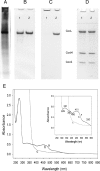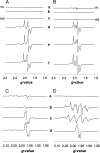The CoxD protein of Oligotropha carboxidovorans is a predicted AAA+ ATPase chaperone involved in the biogenesis of the CO dehydrogenase [CuSMoO2] cluster
- PMID: 19189964
- PMCID: PMC2666610
- DOI: 10.1074/jbc.M805354200
The CoxD protein of Oligotropha carboxidovorans is a predicted AAA+ ATPase chaperone involved in the biogenesis of the CO dehydrogenase [CuSMoO2] cluster
Abstract
CO dehydrogenase from the Gram-negative chemolithoautotrophic eubacterium Oligotropha carboxidovorans OM5 is a structurally characterized molybdenum-containing iron-sulfur flavoenzyme, which catalyzes the oxidation of CO (CO + H(2)O --> CO(2) + 2e(-) + 2H(+)). It accommodates in its active site a unique bimetallic [CuSMoO(2)] cluster, which is subject to post-translational maturation. Insertional mutagenesis of coxD has established its requirement for the assembly of the [CuSMoO(2)] cluster. Disruption of coxD led to a phenotype of the corresponding mutant OM5 D::km with the following characteristics: (i) It was impaired in the utilization of CO, whereas the utilization of H(2) plus CO(2) was not affected; (ii) Under appropriate induction conditions bacteria synthesized a fully assembled apo-CO dehydrogenase, which could not oxidize CO; (iii) Apo-CO dehydrogenase contained a [MoO(3)] site in place of the [CuSMoO(2)] cluster; and (iv) Employing sodium sulfide first and then the Cu(I)-(thiourea)(3) complex, the non-catalytic [MoO(3)] site could be reconstituted in vitro to a [CuSMoO(2)] cluster capable of oxidizing CO. Sequence information suggests that CoxD is a MoxR-like AAA+ ATPase chaperone related to the hexameric, ring-shaped BchI component of Mg(2+)-chelatases. Recombinant CoxD, which appeared in Escherichia coli in inclusion bodies, occurs exclusively in cytoplasmic membranes of O. carboxidovorans grown in the presence of CO, and its occurrence coincided with GTPase activity upon sucrose density gradient centrifugation of cell extracts. The presumed function of CoxD is the partial unfolding of apo-CO dehydrogenase to assist in the stepwise introduction of sulfur and copper in the [MoO(3)] center of the enzyme.
Figures








Similar articles
-
Insights into the posttranslational assembly of the Mo-, S- and Cu-containing cluster in the active site of CO dehydrogenase of Oligotropha carboxidovorans.J Biol Inorg Chem. 2014 Dec;19(8):1399-414. doi: 10.1007/s00775-014-1201-y. Epub 2014 Nov 7. J Biol Inorg Chem. 2014. PMID: 25377894 Free PMC article.
-
The CoxD protein, a novel AAA+ ATPase involved in metal cluster assembly: hydrolysis of nucleotide-triphosphates and oligomerization.PLoS One. 2012;7(10):e47424. doi: 10.1371/journal.pone.0047424. Epub 2012 Oct 15. PLoS One. 2012. PMID: 23077613 Free PMC article.
-
Structural and functional reconstruction in situ of the [CuSMoO2] active site of carbon monoxide dehydrogenase from the carbon monoxide oxidizing eubacterium Oligotropha carboxidovorans.J Biol Inorg Chem. 2005 Aug;10(5):518-28. doi: 10.1007/s00775-005-0006-4. Epub 2005 Sep 23. J Biol Inorg Chem. 2005. PMID: 16091936
-
The role of Se, Mo and Fe in the structure and function of carbon monoxide dehydrogenase.Biol Chem. 2000 Sep-Oct;381(9-10):865-76. doi: 10.1515/BC.2000.108. Biol Chem. 2000. PMID: 11076018 Review.
-
The aerobic CO dehydrogenase from Oligotropha carboxidovorans.J Biol Inorg Chem. 2015 Mar;20(2):243-51. doi: 10.1007/s00775-014-1188-4. Epub 2014 Aug 26. J Biol Inorg Chem. 2015. PMID: 25156151 Review.
Cited by
-
Complete genome and comparative analysis of the chemolithoautotrophic bacterium Oligotropha carboxidovorans OM5.BMC Genomics. 2010 Sep 23;11:511. doi: 10.1186/1471-2164-11-511. BMC Genomics. 2010. PMID: 20863402 Free PMC article.
-
Highly regulated, diversifying NTP-dependent biological conflict systems with implications for the emergence of multicellularity.Elife. 2020 Feb 26;9:e52696. doi: 10.7554/eLife.52696. Elife. 2020. PMID: 32101166 Free PMC article.
-
Correlating carbon monoxide oxidation with cox genes in the abundant Marine Roseobacter Clade.ISME J. 2011 Apr;5(4):685-91. doi: 10.1038/ismej.2010.170. Epub 2010 Nov 11. ISME J. 2011. PMID: 21068776 Free PMC article.
-
The MoxR ATPase RavA and its cofactor ViaA interact with the NADH:ubiquinone oxidoreductase I in Escherichia coli.PLoS One. 2014 Jan 15;9(1):e85529. doi: 10.1371/journal.pone.0085529. eCollection 2014. PLoS One. 2014. PMID: 24454883 Free PMC article.
-
Interaction of Mycobacterium tuberculosis Virulence Factor RipA with Chaperone MoxR1 Is Required for Transport through the TAT Secretion System.mBio. 2016 Mar 1;7(2):e02259. doi: 10.1128/mBio.02259-15. mBio. 2016. PMID: 26933057 Free PMC article.
References
-
- Auling, G., Busse, J., Hahn, M., Hennecke, H., Kroppenstedt, R., Probst, A., and Stackebrandt, E. (1988) Syst. Appl. Microbiol. 10 264-272
-
- Meyer, O. O. (2005) in Bergey′s Manual of Systematic Bacteriology (Garrity, G. M., ed) pp. 468-471, vol. 2, Springer, New York
-
- Fuhrmann, S., Ferner, M., Jeffke, T., Henne, A., Gottschalk, G., and Meyer, O. (2003) Gene (Amst.) 322 67-75 - PubMed
-
- Santiago, B., Schübel, U., Egelseer, C., and Meyer, O. (1999) Gene (Amst.) 236 115-124 - PubMed
MeSH terms
Substances
LinkOut - more resources
Full Text Sources
Molecular Biology Databases

